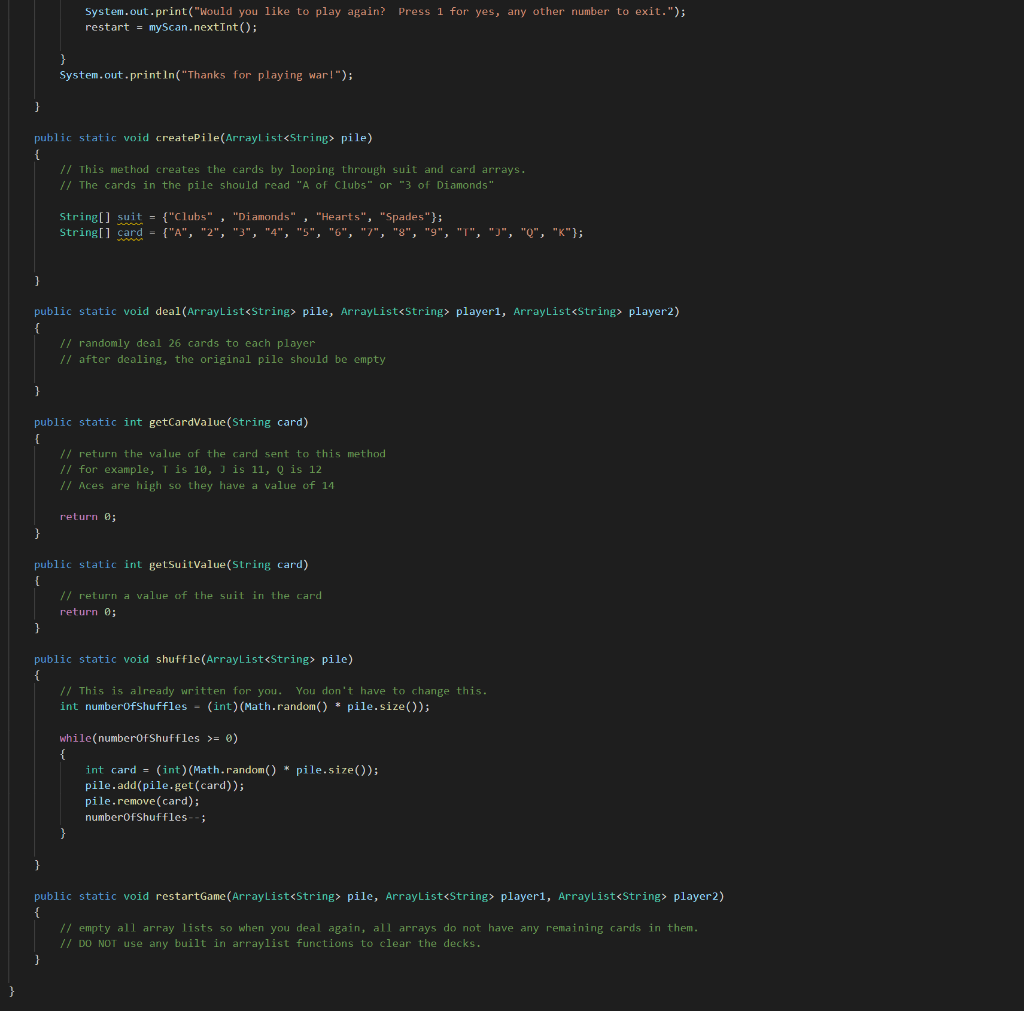Question
Need help with a java game of card program. The code should be written within the code in the picture. Directions are in the comment
Need help with a java game of card program. The code should be written within the code in the picture. Directions are in the comment code. The First half of the code is written and the second half is the image.
import java.util.ArrayList;
import java.util.Scanner;
public class GameOfWar {
/**
*
*
*
* Objective: Play until one player runs out of cards.
* Compare card values. The bigger value wins both cards.
* When there is a tie in the card value, decide based on suit.
* Winning a tie hand results in gaining two more of the opponents cards.
*
* Tie Game:
* Use suit ranking
* Ascending alphabetical order: clubs (lowest), followed by diamonds, hearts, and spades (highest).
* FYI... This ranking is used in the game of bridge.
*/
public static void main(String[] args) {
// The main method structure is generally setup for you but
// is missing several lines. You must have the three ArrayLists
//
Scanner myScan = new Scanner(System.in);
ArrayList
ArrayList
ArrayList
int restart = 1;
System.out.println("Welcome to War!");
while(restart == 1)
{
restartGame(pile, player1, player2);
createPile(pile);
deal(pile, player1, player2);
shuffle(player1);
shuffle(player2);
while(player1.size() > 0 && player2.size() > 0)
{
int value1 = getCardValue(player1.get(0));
int value2 = getCardValue(player2.get(0));
System.out.println(player1.get(0) + " vs. " + player2.get(0));
if(value1 > value2)
{
System.out.println("Player 1 wins that hand");
}
else if(value1
{
System.out.println("Player 2 wins that hand");
}
else // tie
{
// Winning tie hand not only get the two cards played, but two ADDITIONAL cards (see example)
// NOTE: You can only give cards that a player has.
// Suit order from value to most value "Clubs" , "Diamonds" , "Hearts", "Spades"
int player1suit = getSuitValue(player1.get(0));
int player2suit = getSuitValue(player2.get(0));
if(player1suit > player2suit)
{
System.out.println("TIE except Player 1 wins that hand by suit order!");
}
else
{
System.out.println("TIE except Player 2 wins that hand by suit order!");
}
// Shuffle the cards for the players when there is a tie... it reduces the pattern for the same cards.
// Without occasional shuffling, I found myself in an infinite loop after a while. It seemed like the
// cards had ordered themselves into big/small/big/small by the way I was placing the cards at the end of the deck.
// NOTE: You can only shuffle decks that have cards in them.
shuffle(player1);
shuffle(player2);
}
}
if(player1.size() == 0)
{
System.out.println("Player 2 won!");
}
else
{
System.out.println("Player 1 won!");
}

Step by Step Solution
There are 3 Steps involved in it
Step: 1

Get Instant Access to Expert-Tailored Solutions
See step-by-step solutions with expert insights and AI powered tools for academic success
Step: 2

Step: 3

Ace Your Homework with AI
Get the answers you need in no time with our AI-driven, step-by-step assistance
Get Started


